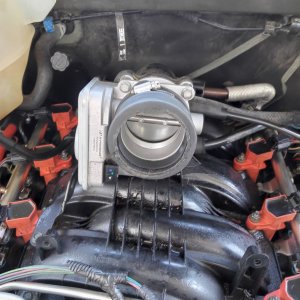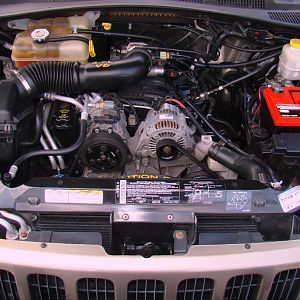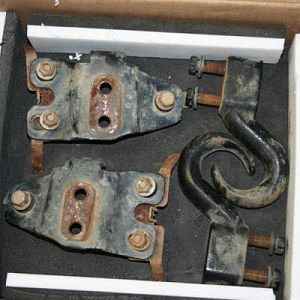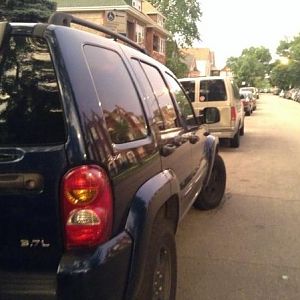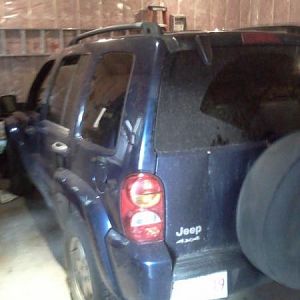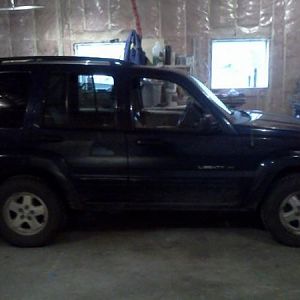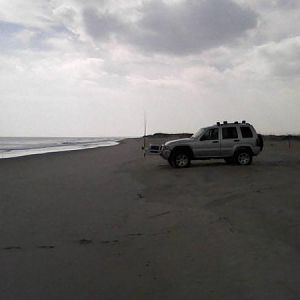Alright, Im getting ready to go down to the Hassayampa River with a friend in the Jeep. Anyway, I already know there are some areas with some very deep sand. What is the best technique for this? I've heard to keep moving back and forth. However, which is ideal 2WD or 4WD? I've heard arguments for both. I'm taking pictures too so hopefully I'll figure out how to post them on here.
You are using an out of date browser. It may not display this or other websites correctly.
You should upgrade or use an alternative browser.
You should upgrade or use an alternative browser.
Driving in Sand
- Thread starter desertkj
- Start date
Disclaimer: Links on this page pointing to Amazon, eBay and other sites may include affiliate code. If you click them and make a purchase, we may earn a small commission.
jfortier777
Full Access Member
I am going to say that 4lo would probably be a big big mistake if you are gonna be driving in deep sand.
I dont have first hand experience in my liberty but I do in other trucks, and one thing that is generally agreed on is that while on the sand, keep moving, and keep moving fast. Tire spin(the good kind) gets you across the sand and any slow movement will assist in your burial.
Deffinetly bring at least 5 gallons of water, a shovel, and maybe some tire ladders.
Don't forget to air down your tires too. I would reccommend staying in 4wd the whole time.
I dont have first hand experience in my liberty but I do in other trucks, and one thing that is generally agreed on is that while on the sand, keep moving, and keep moving fast. Tire spin(the good kind) gets you across the sand and any slow movement will assist in your burial.
Deffinetly bring at least 5 gallons of water, a shovel, and maybe some tire ladders.
Don't forget to air down your tires too. I would reccommend staying in 4wd the whole time.
fouros
Full Access Member
if your driving on sand the first rule is
Drop your tyre pressures to about 18 -20 PSI, it gives you more contact area
another tip is
when pulling up reverse back a few feet after you have stopped your tyres will have a compacted area to rest on
and take a shovel or a spade if you need to dig your self out of a sticky situation,
Drop your tyre pressures to about 18 -20 PSI, it gives you more contact area
another tip is
when pulling up reverse back a few feet after you have stopped your tyres will have a compacted area to rest on
and take a shovel or a spade if you need to dig your self out of a sticky situation,
Well just got back. The Jeep did really well. Didn't get stuck (almost though), and it really didn't try too hard. For a few seconds it went to 5000 rpms, but it went back quickly. I was really surprised. I took it out on some smooth gravel roads for some prerunning too. It handled that well too other than an incredible amount of brake fade over time. I stopped after I decided the brakes weren't performing like I'd like. After they cooled down on the highway home they did fine though. I wonder if stainless brake lines and cross drilled rotors would help the Jeep. And how much of an effect do the rear drums have on braking?
glaurick
Full Access Member
The 2 biggest things are
1. Lower your pressure to around 18PSI in all your tires and once you get moving in the deeper stuff don't slow down stay above 15MPH (Don't stop)
if you park when you start moving again start slow, I like to use a few soft taps on the gas then I steadily apply more gas, never been stuck yet.
Last time I went to corolla I was driving across ruts and acting crazy, and didn't get stuck , the main thing once your going again is don't slow down to much, if your following someone make sure you give them a good lead, if the get stuck just coast to a stop behind them.
1. Lower your pressure to around 18PSI in all your tires and once you get moving in the deeper stuff don't slow down stay above 15MPH (Don't stop)
if you park when you start moving again start slow, I like to use a few soft taps on the gas then I steadily apply more gas, never been stuck yet.
Last time I went to corolla I was driving across ruts and acting crazy, and didn't get stuck , the main thing once your going again is don't slow down to much, if your following someone make sure you give them a good lead, if the get stuck just coast to a stop behind them.
2003KJ
Member
Even though you're already done, i'll post anyways incase anybody stumbles upon this in the future. Having driven in some seriously soft and deep sand, I can tell you driver input makes the difference.
At the time i was on sand, I still had the crapyears which were in crappy shape, and this was at about 24K on my KJ.
I started in 4-hi, slowly crawling along...dont think i got much above 10mph, if that. I parked and got out to take some pictures and enjoy the atmosphere a bit, and then got back in to go drop my stuff off at the house i was stayin at. Leaving the beach I put it in 4-lo just to be on the safe side and didn't have one single problem. And keep in mind, I had just driven 4 hours non stop in 90*+ heat at 80mph, to the island, down the entire island, and then just threw it in 4 hi and on the beach I went. Didn't air down my tires or anything and I didn't have a single problem.
Just take it slow and pay attention to what you're doing and you'll be fine. Once you get a feel for how differently your Jeep is going to handle on sand you'll be more comfortable with it.
In this shot, I was on much harder sand, and back in 4-hi.
At the time i was on sand, I still had the crapyears which were in crappy shape, and this was at about 24K on my KJ.
I started in 4-hi, slowly crawling along...dont think i got much above 10mph, if that. I parked and got out to take some pictures and enjoy the atmosphere a bit, and then got back in to go drop my stuff off at the house i was stayin at. Leaving the beach I put it in 4-lo just to be on the safe side and didn't have one single problem. And keep in mind, I had just driven 4 hours non stop in 90*+ heat at 80mph, to the island, down the entire island, and then just threw it in 4 hi and on the beach I went. Didn't air down my tires or anything and I didn't have a single problem.
Just take it slow and pay attention to what you're doing and you'll be fine. Once you get a feel for how differently your Jeep is going to handle on sand you'll be more comfortable with it.
You must be registered for see images
You must be registered for see images
You must be registered for see images
In this shot, I was on much harder sand, and back in 4-hi.
You must be registered for see images
jfortier777
Full Access Member
I will contest that theory. On three counts.
1st - You and many other mistaken KJers use 4LO WAY too often and for the wrong reasons.
It is for situations where extra traction is needed, but only when it is available. You cannot mix that up. Deep mud is a situation where serious extra traction is needed but is not available, therefore wheel spin has to make up the difference for you; momentum is the key. Sand is practically the same as deep mud as far as the traction situation, I just used it as an easier example to understand.
4LO is not something you use when 4HI just isnt enough. They are for completely seperate applications with specific requirements for each.
2nd - The sand in that picture is not deep, nor threatening, I dont think it would even be necessary to air down on a beach like that much less use 4LO. So if that is the experience you are basing your theory on, than I will say thay you have yet to encounter "jeep sand".
3rd - Slow is bad! The only time its okay to go really slow on sand is right when you are first accelerating; otherwise you need to maintain a quick pace. drive.gif
I will stress again.
NO 4LO IN THE SAND. [-X NO! NO! BAD! *Slaps 2003KJ's hand* =;
Also, heres a maxim for everyone:
If you every find yourself stuck and think that you'll need 4LO to get out...
...then the mistake was made before you started.
Disclaimer: None of this is meant in a rude way at all, only with intent to better our entire community of strong, proud, and informed liberty ownersowners
1st - You and many other mistaken KJers use 4LO WAY too often and for the wrong reasons.
It is for situations where extra traction is needed, but only when it is available. You cannot mix that up. Deep mud is a situation where serious extra traction is needed but is not available, therefore wheel spin has to make up the difference for you; momentum is the key. Sand is practically the same as deep mud as far as the traction situation, I just used it as an easier example to understand.
4LO is not something you use when 4HI just isnt enough. They are for completely seperate applications with specific requirements for each.
2nd - The sand in that picture is not deep, nor threatening, I dont think it would even be necessary to air down on a beach like that much less use 4LO. So if that is the experience you are basing your theory on, than I will say thay you have yet to encounter "jeep sand".
3rd - Slow is bad! The only time its okay to go really slow on sand is right when you are first accelerating; otherwise you need to maintain a quick pace. drive.gif
I will stress again.
NO 4LO IN THE SAND. [-X NO! NO! BAD! *Slaps 2003KJ's hand* =;
Also, heres a maxim for everyone:
If you every find yourself stuck and think that you'll need 4LO to get out...
...then the mistake was made before you started.
Disclaimer: None of this is meant in a rude way at all, only with intent to better our entire community of strong, proud, and informed liberty ownersowners
2003KJ
Member
I see your point, but I must contest your contestment.
1 - This is the first time I ever used 4-lo, I used it only to see how it performed in deep sand, and I was extremely impressed with it. I had minimal wheel spin in both 4-hi and 4-lo.
2nd - These pictures dont do it justice. The sand there was much deeper than it lookes, and much softer than it looks, especially behind where I was parked (which you obviously can't see b/c i didn't get any shots of that area)
3rd - slow is not bad. What you also dont see in the pics are the several families running around the area. So when I come plowing through there at say 15 or 20mph, I guess i'll just mow down the little kids if they dont get out of my way fast enough? Taking it slow and steady assures that you have better control over your vehicle, incase you do get stuck.
I will state once again, driver input makes the difference when driving on sand. Once you get a feel for how your Jeep is going to handle, it's your call on speed, and which 4x4 setting to use.
And I'm going to go ahead and say this now before things get way out of hand, i'm not calling you a liar by any means at all. I'm simply stating my experiences, which worked very well for me in the past, and will more than likely continue to do so in the future when I go back down there.
1 - This is the first time I ever used 4-lo, I used it only to see how it performed in deep sand, and I was extremely impressed with it. I had minimal wheel spin in both 4-hi and 4-lo.
2nd - These pictures dont do it justice. The sand there was much deeper than it lookes, and much softer than it looks, especially behind where I was parked (which you obviously can't see b/c i didn't get any shots of that area)
3rd - slow is not bad. What you also dont see in the pics are the several families running around the area. So when I come plowing through there at say 15 or 20mph, I guess i'll just mow down the little kids if they dont get out of my way fast enough? Taking it slow and steady assures that you have better control over your vehicle, incase you do get stuck.
I will state once again, driver input makes the difference when driving on sand. Once you get a feel for how your Jeep is going to handle, it's your call on speed, and which 4x4 setting to use.
And I'm going to go ahead and say this now before things get way out of hand, i'm not calling you a liar by any means at all. I'm simply stating my experiences, which worked very well for me in the past, and will more than likely continue to do so in the future when I go back down there.
Marlon_JB2
Kombat Edition Jeep
Sure it is. Back in the GY Wrangler STs days of my red KJ, My tires + ice + cold Michigan concrete = frozen in place. I hit the gas and I wasn't going anywhere.... at all. The solution? Neutral + 4LO + Reverse = Unstuck. Broke the ice and away I went! \jfortier777 said:4LO is not something you use when 4HI just isnt enough. They are for completely seperate applications with specific requirements for each.
lol3.gif
Silver Streak
New Member
I drive my CRD on the beach here in Florida, fairly often. Sand is all you have on the beach, some of it is soft, but a good bit of it can be packed well too. The soft sand is usually worst at the entry/exit ramps to the beach, where you first drive down onto the beach from the roads. I have never had to use 4Lo to drive anywhere on the beach, but i have used it to pull others out there were stuck in the sand. I don't air the tires down unless i have a problem, and with the KJ i have never had that much trouble.
I expect you could use most any driving style that makes sense, and the Jeep will keep you out of trouble. It has the capability to let you be a greenhorn and feel your way around, without getting in over your head in the sand. Real wet mud is another story of course. Don't fear the sand, you will be ok in a KJ.
Silver Streak
`05 CRD Sport
I expect you could use most any driving style that makes sense, and the Jeep will keep you out of trouble. It has the capability to let you be a greenhorn and feel your way around, without getting in over your head in the sand. Real wet mud is another story of course. Don't fear the sand, you will be ok in a KJ.
Silver Streak
`05 CRD Sport
jfortier777
Full Access Member
Marlon_JBT said:Sure it is. Back in the GY Wrangler STs days of my red KJ, My tires + ice + cold Michigan concrete = frozen in place. I hit the gas and I wasn't going anywhere.... at all. The solution? Neutral + 4LO + Reverse = Unstuck. Broke the ice and away I went! \/
That is a great application for 4LO.
jfortier777
Full Access Member
2003KJ said:I see your point, but I mu......
I have said all I needed to already, but I will add one more bit of info to this discussion.
Many driving styles will "work", but not all of them are correct. With minor offroading these things are not noticed. However if a person learns the incorrect way to do something then they can/will end up in an unpleasant situation when a real challenge presents itself.
2003KJ
Member
jfortier777 said:2003KJ said:I see your point, but I mu......
I have said all I needed to already, but I will add one more bit of info to this discussion.
Many driving styles will "work", but not all of them are correct. With minor offroading these things are not noticed. However if a person learns the incorrect way to do something then they can/will end up in an unpleasant situation when a real challenge presents itself.
Agreed....however I just wanted to make it clear that 4lo can be used in other situations besides the extreme ones.
JeepJeepster
Full Access Member
If it was me, and I was in sand, I would use 4low. I would keep it in 2nd and do about 5-10mph. The wider the tire the better, so I would do purty good there and air down to about 25psi. I like kids since I used to be a kid so I would keep it slow when i could. I like my ****** to much to cook it by using 4high.
Another good reason to not "tear ass" at high speeds, is think of what will happen if you hit a soft patch and bury the front end or hit a covered object (rock, limb, etc.). At higher sppeds you are more likely to cause serious harm to your kj. Taking it a little slower ya you may get stuck, but at least you won't have to stop at the body shop on the way home.
glaurick
Full Access Member
no one said to tear **** in the sand I stay at around 20MPH, for some beaches I guess 5-10 would be ok, but I wish some of you that have only been on beaches like Daytona could drive the right side pass of Oregon Inlet, NC at 5-10 MPH and you'd get stuck in a hurry.
HOW TO DRIVE ON SAND
by
Bob White
Today I’ll answer one of the most ‘oft asked questions and one of the best-kept secrets on the Banks..."how to drive on sand". I and my crack team of research assistants have spent years of careful, meticulous, scientific research; questioned the few superior authorities (namely, teenage boys in two-wheel drive pick-up trucks, and 90 year-old natives ...but never, ever questioned anyone in any truck whose tires I couldn't’t see over), and, as usual, I’ve stripped away the chafe and arrived at a simple axiom, that if followed, guarantees a perfect sand-driving record. IT IS SIMPLY THIS: "NEVER LOSE YOUR MOMENTUM!"
Easily said, but, hard to do. In fact, put a different way, it ranks right up there with what your Momma said about your virginity, ..but you didn’t listen to her either, did you? Like most laws of nature, this one requires more explanation and additional sub-laws for understanding. Three major sub-laws are:
Let lots of air out your tires. How much is "lots of air"? Lots more than you think. See "valve stem remover" below.
Use bald tires (in fact, think big ~4 bald).
Have 4-wheel drive available.
Surprised that 4-wheel drive is last instead of first? It’s last, because as the above-mentioned teenagers and old natives know...you hardly ever, ever need 4WD or lose momentum if you run very low pressures and have wide, slick tires. Why? Because, contrary to what seems logical, what you’re really trying to do is float on the sand Aggressive tire patterns (the kind of tires that come on every 4WD yuppiemobile ever made) and high tire pressures make the tire "bite" into the sand and make you violate the first axiom lose your momentum. Here’s the hierarchy of tire tread patterns from best to worse:
Racing slicks with no tread
Worn-out (bald) street tires of any size and description
Street tires with a simple tread pattern
All-season tread patterns
Mud and snow tread patterns
Some other minor rules (sub-sets) are:
Never drive in very soft sand for any distance, without letting lots of air out of your tires. How much is "lots of air"? More than you think. ( See "valve stem remover" below).
Have sufficient ground clearance. Cars with low ground clearance, i.e., a sports car, a Nascar (even if it does has racing slicks), and probably even a front-wheel drive car, just ain’t gonna make it in the sand because of ground clearance. And, if you remember anything from your Physics 101 class, you’ll remember that "sufficient ground clearance is directly proportional to your girth."
In other words, if you can’t crawl under your car, don’t drive in sand. And, the litter (excuse me, more "rotund") you are, the deeper the sand you’re able to drive in (all else being equal).
"Momentum" and "stop immediately" axioms are nearly impossible to obey. Logically (by the way, logic goes out the window when you’re in sand), it would seem that if you lose momentum, you would naturally slow down and come to a stop, right? Wrongamongo. What really happens is that your logic goes to the same place the mates to your socks go, and even though you know you’ve got to stop, that you’re just burying your car and making things worse; your right leg (gas pedal) muscles lock-up in a huge spasm because the left side of your brain (the emotional and voluntary muscle side) is ignoring the right-side brain (the logical side) and the left side" makes you continue to drive on, all-the-while, all your other heightened senses are screaming, ‘you’re down to the frame! Stop! Stop! Abort! Abort! Danger! Danger!" But you keep on throwing up sand until finally the Right side (logical-side) brain regains control of course, by then your car is covered in sand, and you give real consideration to just leaving it there as a memorial for future archeologists to find.
Back-up! For some reason, inexplicable by all the rules of nature, physics, and common sense, you can almost always back up in sand even if you can’t go forward Unless, of course, you’ve violated the "stop all forward progress" rule above and you are buried up to the frame, as, you undoubtedly have.
Always carry a small shovel. An "Army" fold-up perfect. Murphy’s #4 law states: "The only time you get stuck up to the axles is when you forget your shovel."
Don’t let your vehicle intimidate you! You are the master of your car! Be aggressive! Be assertive! Show it who’s boss! When you’re "plowing" through soft sand; when your car’s engine is starting to sound like a wounded buffalo; when your heart is pounding louder than an Indian tom-tom contest; and when your car is losing forward speed....NOW’S THE TIME TO FLOOR IT! SHOW THAT SUCKER WHO’S BOSS, WHO’S THE MASTER, WHO’S NUMERO UNO, THE TOP ENCHILADA...Keep it pegged...or, or, go ahead and stop Cause you’ll have to sooner or later), let lots of air out of your tires and continue on...content in the knowledge that you could have showed it who’s boss.
Always carry a "valve stem remover." It takes forever to let "lots of air" out of the tires by holding the valve stem down. You will get nervous about the amount of air you’ve let out long before the job’s done and stop too soon. Optimum low tire pressure is 15-18 lbs. In big tires and 5 to 8 lbs. In street tires. Regular street tires hold about 32 lbs. of pressure, and big ‘ole truck tires hold up to 50 lbs. of pressure; and, in controlled, scientific studies rye conducted, persons letting air out by holding the valve stem down, get nervous around the 31 lb. (If they started at 32 lbs.), and stop at 30 lbs., which brings us to the next item the savvy beach cruiser carries...
Have a tire pressure gauge handy to measure actual pressures. But before we talk about measuring pressure, let’s talk about how to get the air out with a hot tip on letting air out of your tires: This method has been tested on thousands of tires of all shapes, sizes, and pressures, but you have to believe, with oil your heart that it works, because the first few times you do it, you will get very nervous (and, maybe deep down, even have doubts). The method is this; take your handy-dandy valve stem remover and remove the valve stem completely from the valve. Air will come rushing out (in scientific circles, its not rushing out but being "sucked" out by the lower atmospheric pressure—but I digress). Here’s where you get nervous and may have doubts, because its takes a long time to let "lots of air" out of your tire, especially when most 4WD tires carry 45 lbs. of pressure in them. You have to wait...wait...wait. All the while, air is rushing out of the tires But, what you are waiting for— and listening for—is a change in "pitch". The air will start to whistle as it reaches the 18-20 LB range (3-10 lbs. on street tires). Quickly, replace the valve stem...and yes, of little faith, may now wish to check the pressure with the pressure gauge you now always carry with you and, viola! The pressure will be between 15-18 lbs.—the optimum pressure for Imp tires (for small tires, it will be around 5-8 lbs. of pressure). It works every time And’ soon, you won’t need the pressure gauge, which is good, because you’ll probably lose it anyway.
Let lots of air out of all your tires! And, it doesn’t matter whether you have two-wheel drive or four-wheel drive; you have to let lots of air out of the front tires, too! And, list, the acid test about this "lots of air" thing, is this; If you’re stuck, and have let "lots of air" out, but, you’re not down to the frame, and you still can’t move, it means.... You still haven’t let enough air out of your tires! You haven’t been listening! Your tires need to be almost flat. You need to be nervous about the way they look.
Don’t worry, they won’t go completely flat on you...but you will need to get them pumped up as soon as you can once you’re back on the hard surface).
HOW TO DRIVE ON SAND
by
Bob White
Today I’ll answer one of the most ‘oft asked questions and one of the best-kept secrets on the Banks..."how to drive on sand". I and my crack team of research assistants have spent years of careful, meticulous, scientific research; questioned the few superior authorities (namely, teenage boys in two-wheel drive pick-up trucks, and 90 year-old natives ...but never, ever questioned anyone in any truck whose tires I couldn't’t see over), and, as usual, I’ve stripped away the chafe and arrived at a simple axiom, that if followed, guarantees a perfect sand-driving record. IT IS SIMPLY THIS: "NEVER LOSE YOUR MOMENTUM!"
Easily said, but, hard to do. In fact, put a different way, it ranks right up there with what your Momma said about your virginity, ..but you didn’t listen to her either, did you? Like most laws of nature, this one requires more explanation and additional sub-laws for understanding. Three major sub-laws are:
Let lots of air out your tires. How much is "lots of air"? Lots more than you think. See "valve stem remover" below.
Use bald tires (in fact, think big ~4 bald).
Have 4-wheel drive available.
Surprised that 4-wheel drive is last instead of first? It’s last, because as the above-mentioned teenagers and old natives know...you hardly ever, ever need 4WD or lose momentum if you run very low pressures and have wide, slick tires. Why? Because, contrary to what seems logical, what you’re really trying to do is float on the sand Aggressive tire patterns (the kind of tires that come on every 4WD yuppiemobile ever made) and high tire pressures make the tire "bite" into the sand and make you violate the first axiom lose your momentum. Here’s the hierarchy of tire tread patterns from best to worse:
Racing slicks with no tread
Worn-out (bald) street tires of any size and description
Street tires with a simple tread pattern
All-season tread patterns
Mud and snow tread patterns
Some other minor rules (sub-sets) are:
Never drive in very soft sand for any distance, without letting lots of air out of your tires. How much is "lots of air"? More than you think. ( See "valve stem remover" below).
Have sufficient ground clearance. Cars with low ground clearance, i.e., a sports car, a Nascar (even if it does has racing slicks), and probably even a front-wheel drive car, just ain’t gonna make it in the sand because of ground clearance. And, if you remember anything from your Physics 101 class, you’ll remember that "sufficient ground clearance is directly proportional to your girth."
In other words, if you can’t crawl under your car, don’t drive in sand. And, the litter (excuse me, more "rotund") you are, the deeper the sand you’re able to drive in (all else being equal).
"Momentum" and "stop immediately" axioms are nearly impossible to obey. Logically (by the way, logic goes out the window when you’re in sand), it would seem that if you lose momentum, you would naturally slow down and come to a stop, right? Wrongamongo. What really happens is that your logic goes to the same place the mates to your socks go, and even though you know you’ve got to stop, that you’re just burying your car and making things worse; your right leg (gas pedal) muscles lock-up in a huge spasm because the left side of your brain (the emotional and voluntary muscle side) is ignoring the right-side brain (the logical side) and the left side" makes you continue to drive on, all-the-while, all your other heightened senses are screaming, ‘you’re down to the frame! Stop! Stop! Abort! Abort! Danger! Danger!" But you keep on throwing up sand until finally the Right side (logical-side) brain regains control of course, by then your car is covered in sand, and you give real consideration to just leaving it there as a memorial for future archeologists to find.
Back-up! For some reason, inexplicable by all the rules of nature, physics, and common sense, you can almost always back up in sand even if you can’t go forward Unless, of course, you’ve violated the "stop all forward progress" rule above and you are buried up to the frame, as, you undoubtedly have.
Always carry a small shovel. An "Army" fold-up perfect. Murphy’s #4 law states: "The only time you get stuck up to the axles is when you forget your shovel."
Don’t let your vehicle intimidate you! You are the master of your car! Be aggressive! Be assertive! Show it who’s boss! When you’re "plowing" through soft sand; when your car’s engine is starting to sound like a wounded buffalo; when your heart is pounding louder than an Indian tom-tom contest; and when your car is losing forward speed....NOW’S THE TIME TO FLOOR IT! SHOW THAT SUCKER WHO’S BOSS, WHO’S THE MASTER, WHO’S NUMERO UNO, THE TOP ENCHILADA...Keep it pegged...or, or, go ahead and stop Cause you’ll have to sooner or later), let lots of air out of your tires and continue on...content in the knowledge that you could have showed it who’s boss.
Always carry a "valve stem remover." It takes forever to let "lots of air" out of the tires by holding the valve stem down. You will get nervous about the amount of air you’ve let out long before the job’s done and stop too soon. Optimum low tire pressure is 15-18 lbs. In big tires and 5 to 8 lbs. In street tires. Regular street tires hold about 32 lbs. of pressure, and big ‘ole truck tires hold up to 50 lbs. of pressure; and, in controlled, scientific studies rye conducted, persons letting air out by holding the valve stem down, get nervous around the 31 lb. (If they started at 32 lbs.), and stop at 30 lbs., which brings us to the next item the savvy beach cruiser carries...
Have a tire pressure gauge handy to measure actual pressures. But before we talk about measuring pressure, let’s talk about how to get the air out with a hot tip on letting air out of your tires: This method has been tested on thousands of tires of all shapes, sizes, and pressures, but you have to believe, with oil your heart that it works, because the first few times you do it, you will get very nervous (and, maybe deep down, even have doubts). The method is this; take your handy-dandy valve stem remover and remove the valve stem completely from the valve. Air will come rushing out (in scientific circles, its not rushing out but being "sucked" out by the lower atmospheric pressure—but I digress). Here’s where you get nervous and may have doubts, because its takes a long time to let "lots of air" out of your tire, especially when most 4WD tires carry 45 lbs. of pressure in them. You have to wait...wait...wait. All the while, air is rushing out of the tires But, what you are waiting for— and listening for—is a change in "pitch". The air will start to whistle as it reaches the 18-20 LB range (3-10 lbs. on street tires). Quickly, replace the valve stem...and yes, of little faith, may now wish to check the pressure with the pressure gauge you now always carry with you and, viola! The pressure will be between 15-18 lbs.—the optimum pressure for Imp tires (for small tires, it will be around 5-8 lbs. of pressure). It works every time And’ soon, you won’t need the pressure gauge, which is good, because you’ll probably lose it anyway.
Let lots of air out of all your tires! And, it doesn’t matter whether you have two-wheel drive or four-wheel drive; you have to let lots of air out of the front tires, too! And, list, the acid test about this "lots of air" thing, is this; If you’re stuck, and have let "lots of air" out, but, you’re not down to the frame, and you still can’t move, it means.... You still haven’t let enough air out of your tires! You haven’t been listening! Your tires need to be almost flat. You need to be nervous about the way they look.
Don’t worry, they won’t go completely flat on you...but you will need to get them pumped up as soon as you can once you’re back on the hard surface).
JeepJeepster
Full Access Member
Ive never driven on daytona nor been there. :-$ Im sure the sand is super soft. 8-[
jfortier777
Full Access Member
2003KJ
Member
I still think slow and steady is the best way to do it, but thats based on my experiences that worked for me in the past.
Similar threads
- Replies
- 9
- Views
- 5K
- Replies
- 9
- Views
- 2K
- Replies
- 42
- Views
- 9K


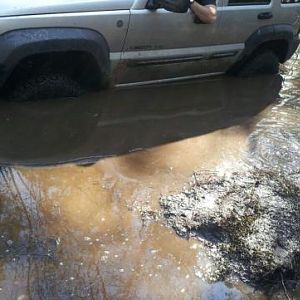
![102109 1223[01]](/data/xfmg/thumbnail/2/2279-7b91dc5afd9396823de56ed34464f457.jpg?1623784618)
